Why scout for insect pests?
On average, we lose 20% of our yield to insect pests. The first step of a successful insect management program is scouting. Understanding if your pests have reached economically damaging levels is important prior to choosing a management strategy. At crop emergence, check for aboveground feeding damage or wilting, and search for plants cut at the base for larval insects.
If you find concerning damage, check around the plant for the culprit. The best way to identify a pest is to catch it in the act. Early season feeding damage by many insect pests may look similar. Correctly identifying the pest and its life stage is important prior to choosing a management strategy.
Economic thresholds refer to the pest density or level of damage at which a control measure is needed to prevent economic loss.
Consult economic thresholds when deciding whether to control an insect pest. Economic thresholds refer to the pest density or level of damage at which a control measure is needed to prevent economic loss. An economic loss would occur when the cost of the insect damage (e.g., yield or quality) exceeds the cost of control.
Beneficial insects and conservation practices
Remember, not all insects are pests! Numerous beneficial insects like pollinators, parasitoids, and generalist predators live in our croplands and provide ecosystem services that are valuable for agricultural production. Spraying a broad-spectrum insecticide may end up hurting your yield!
Conservation cropping practices, like reduced tillage and cover crops, can provide food and habitat for beneficial insects (e.g., ground beetles) in the spring and early in the growing season. Alternatively, cover crops and reduced soil disturbance can also support field crop pests in certain scenarios (e.g., moths, flies, and slugs). As a result, diligent scouting for early-season pests becomes especially important in conservation cropping systems.
Early season insect scouting in soybean
Bean leaf beetle scouting
Bean leaf beetles are above ground soybean pests. Adults are similar to corn rootworm beetles in size and shape; however, they have various patterns of black geometric shapes on their wing covers and can be pale yellow, green or crimson (Figure 1). Bean leaf beetles always have a black triangle behind the thorax in the “neck” region.
Adults overwinter in Wisconsin under plant residue and loose soil. In the spring, bean leaf beetles emerge and feed on alfalfa, clover and wild legumes. Then, they move to early planted soybean fields. They have two generations per year.
Adult beetles lay eggs in the soil next to soybean stems. The larvae hatch and feed on soybean root nodules and root hairs but are not an economic concern. Adult beetles chew round holes in soybean leaves, peduncles and bean pods later in the season (Figure 2). The primary concern with bean leaf beetle is the transmission of bean pod mottle virus.
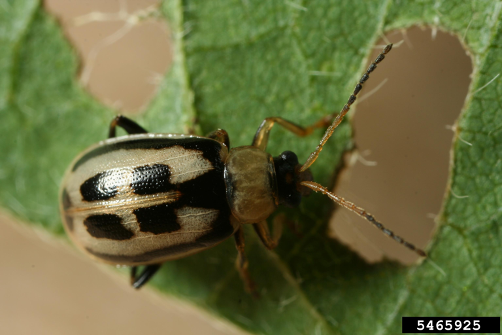
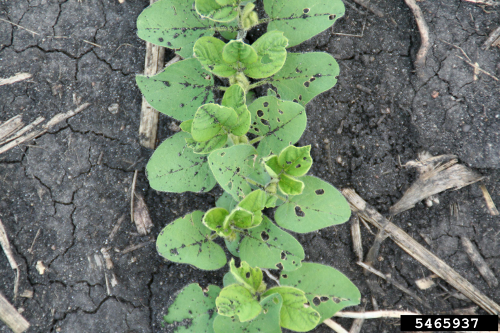
Your field might be at higher risk for bean leaf beetle damage if you:
- Plant soybeans early
- Plant soybeans near alfalfa fields
- Have crop residue or weedy field conditions
- Have a history of high bean leaf beetle populations or bean pod mottle virus
- Have cool or wet soil conditions
Mild winters and crop residue favor the survival of bean leaf beetles. Cool, wet conditions slow down the growth of young plants making them more susceptible to bean leaf beetle feeding damage.
Scout for overwintered beetles when soybeans emerge. Count the number of beetles on each plant and determine a field average. Scout again during first-crop alfalfa harvest since beetles may move to soybean.
The economic threshold for overwintered bean leaf beetle considers the crop value, cost of treatment, and growth stage of the soybean plant. Consult Table 3-5 in Pest Management in Wisconsin Field Crops (A3646) for first (July) and second (August-September) generation bean leaf beetle economic thresholds.
Slug scouting in soybean
Slugs are above ground soybean pests. Slugs are molluscs (Figure 3), not insects. This means slugs cannot be controlled with insecticides.
Slugs typically overwinter as eggs in the soil, but adults can survive mild winters. Slugs feed on plant surfaces with “rasp-like” mouthparts. In soybean, slug feeding results in holes in the cotyledons and scraped ragged holes on the leaves (Figure 4). Severe damage to the above ground growing point on soybeans leads to plant death and stand loss.
Your field might be at higher risk for slug damage if you:
- Have crop residue or weedy field conditions
- Have no-till or reduced till fields
- Have cool or wet soil conditions
- Have a wet spring following a mild winter
- Use insecticide seed treatments, which harm slug-predator insects
Slugs are nocturnal feeders. During the day, they seek shelter in soil crevices and under crop residue. Cool, wet conditions slow down the growth of young plants and make them more vulnerable to slug feeding.
Scout for slugs immediately after planting and emergence. Check wet, low-lying or weedy parts of fields that are likely to provide good slug habitat. You can use a refuge trap to scout for slugs. Traps, commonly made from roofing shingles, rest on the soil surface and slugs seek shelter underneath during the day.
There are no economical thresholds for slug control in Wisconsin. Metaldehyde-based baits are not registered for use on soybeans in Wisconsin.
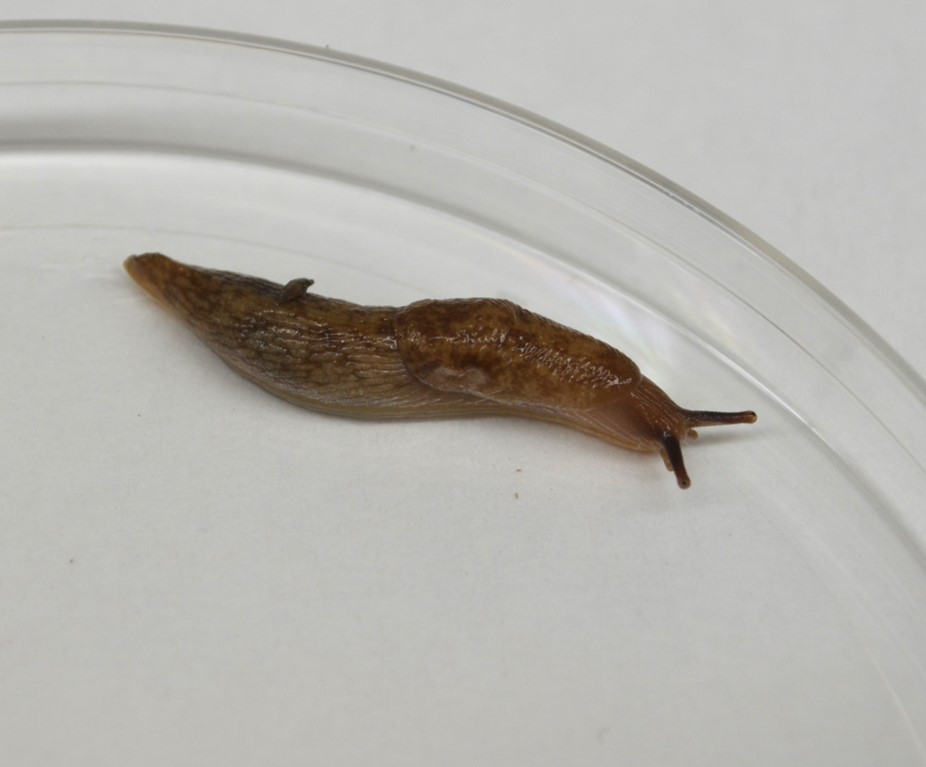

Soybean defoliator scouting
Soybean defoliators are above ground pests of soybean that eat soybean foliage. They include grasshoppers, green cloverworm, soybean looper, and thistle caterpillars. Each defoliator has a unique life cycle and will become active at a different time.
Symptoms of soybean defoliators are irregular holes in leaves, lacing, and feeding on leaf margins. Scout for defoliation over the entire plant and determine the percent defoliation per plant (Figure 5). If you only look at the upper canopy, you may overestimate the extent of defoliation.

Treatment is suggested if defoliation reaches 30% before bloom. Control strategies will depend on the pest causing the defoliation. Identify the pest by catching it in the act using a sweep net, before choosing an appropriate chemical control.
Seedcorn maggots in soybean
Seedcorn maggot is a below ground pest in soybean. The name ‘seedcorn maggot’ is misleading, as the fly larvae feed on a wide range of food, including soybean seeds, but also manure. Soybean is more susceptible to seedcorn maggot damage than corn. Larvae called maggots are 3/16 of an inch long, white and cigar shaped (Figure 6). The adults look like small houseflies (Figure 7).
Seedcorn maggots feed on the seed, hypocotyl and cotyledon (Figure 8). Damaged seeds may fail to germinate and emerge, leaving gaps in rows. Like in corn, a common indicator of seedcorn maggot infestation is stand loss. “Snakehead” damage is when the hypocotyl emerges through the soil, but the cotyledon is cut off. Plants can survive damage from seedcorn maggot if the growing point remains intact; in soybeans, this is above ground.
Seedcorn maggot has four to five generations per year. The first three generations (360, 1080, and 1800 degree-days, base temperature 39˚F) are most problematic.
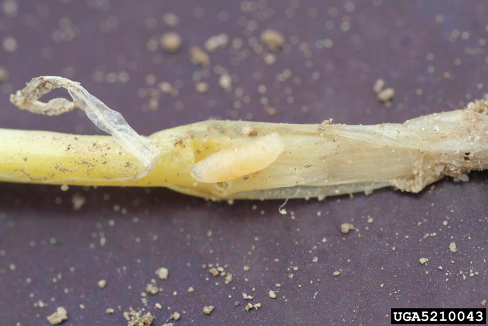
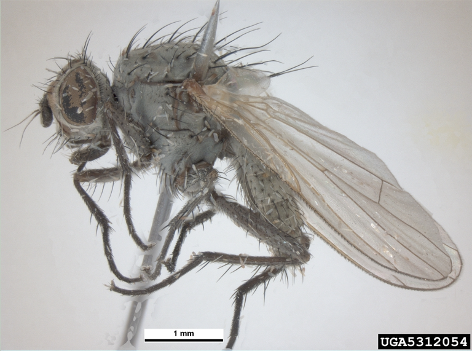
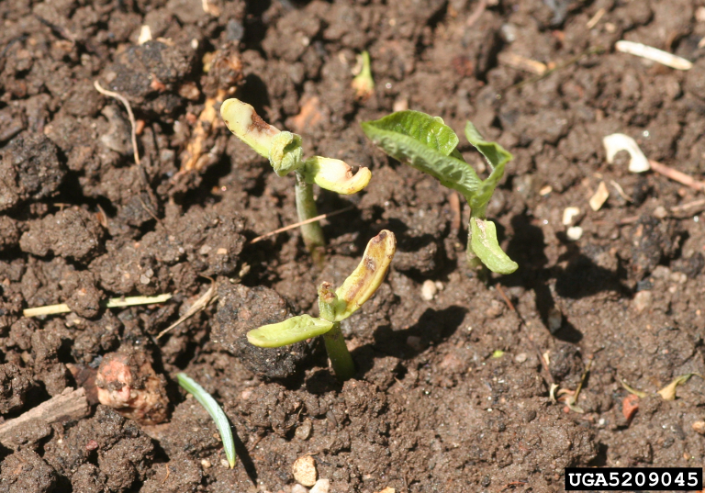
Your field might be at higher risk for seedcorn maggot damage if you:
- Plow down green manure
- Apply livestock manure
- Have recently tilled
- Have cool or wet soil conditions
Adult flies are attracted to decaying organic matter and newly tilled fields where they prefer to lay eggs. No-till fields are less attractive to egg-laying females. Cool and wet soil conditions slow seed germination and emergence which increases the risk of seedcorn maggot damage.
There are no economic thresholds for seedcorn maggot, nor are there reliable rescue treatment options. You must scout fields to identify damage caused by seedcorn maggot and develop a field history to plan for management in future years.
Additional Resources
Current Wisconsin pest management recommendations
Consult Pest Management in Wisconsin Field Crops (A3646): A guide to managing weeds, insects, and diseases in corn, soybean, forages and small grains for current management recommendations for early season pests in corn and soybean.
Insect pest text alerts
Sign up for the Bick Lab’s collaborative Insect Pest Text Alert service with Extension and WI DATCP to find out what insect pests are emerging and active in fields near you.
Other common insect and disease information
Learn more about common insects and diseases in Wisconsin corn from the UW-Madison Division of Extension.
- Generalized Calendar of Events for Insects and Disease in Wisconsin SOYBEAN
- Pest Management in Wisconsin Field Crops (A3646): A guide to managing weeds, insects, and diseases in corn, soybean, forages and small grains
- UW Pest Management Fast Facts
References
Updated: May 2, 2025
Reviewed by: Emily Bick

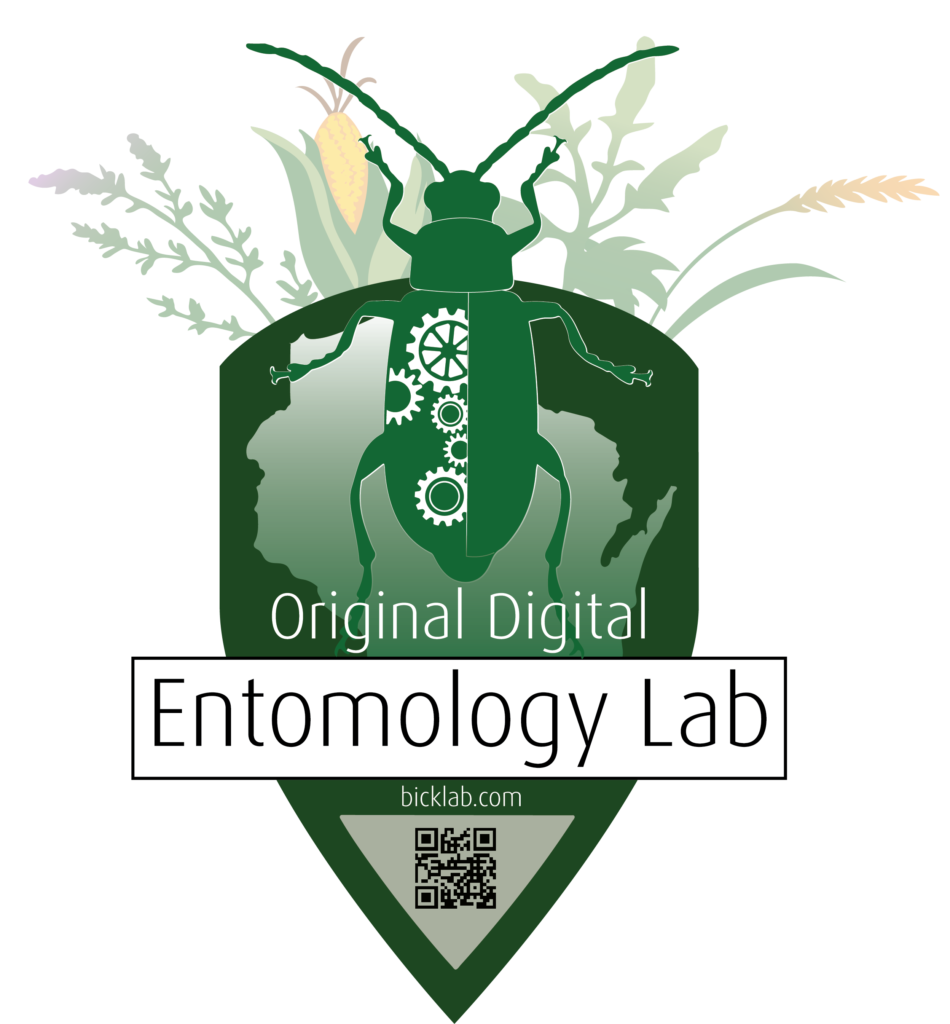
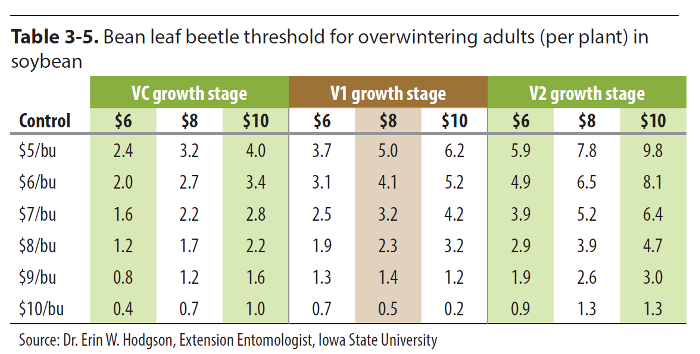
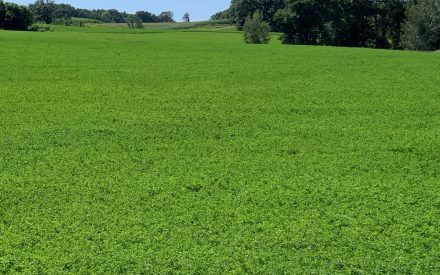 First crop insect scouting in alfalfa
First crop insect scouting in alfalfa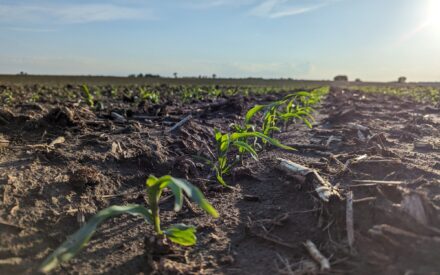 Early season insect scouting in corn
Early season insect scouting in corn Managing Slugs in Wisconsin Field Crops
Managing Slugs in Wisconsin Field Crops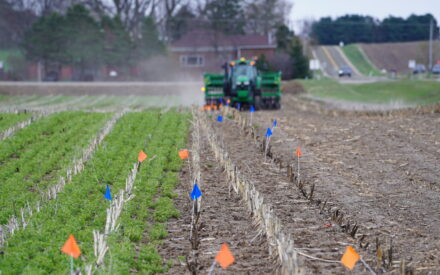 ▶ Considerations for 2026 Seed Selection
▶ Considerations for 2026 Seed Selection


